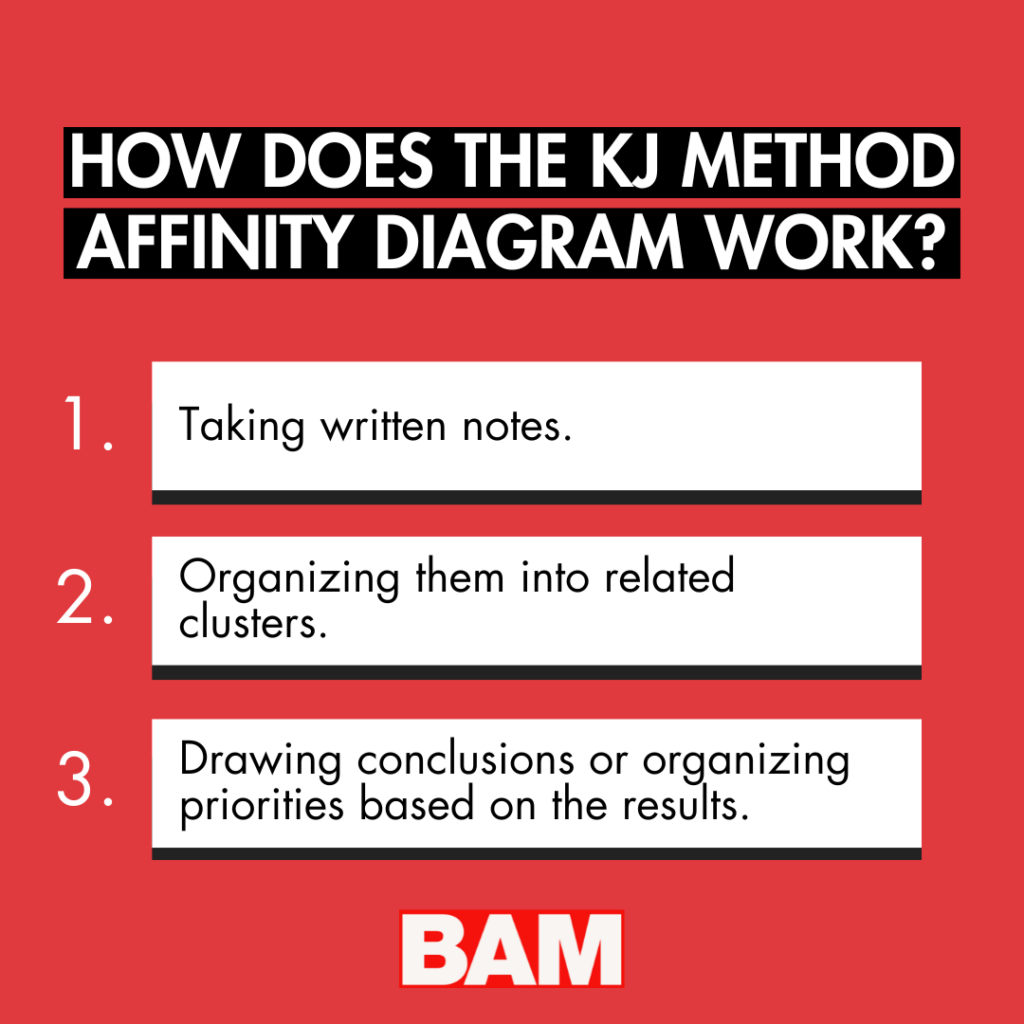Stop Wasting Notes! Organize Them Digitally Using The KJ Method Affinity Diagram
Quick Summary: KJ Method Affinity Diagram is a technique for organizing and synthesizing large volumes of information, which can be particularly helpful following meetings with copious notes and ideas. This method is valuable in various applications such as project planning, product development, and process improvement, and can be executed using traditional materials like post-it notes and whiteboards or digitally with tools like Google Sheets or Excel. The KJ Method is popular in brainstorming sessions and is used both individually and in teams to manage complex information effectively.
Peep this scene: you just ended an intense client meeting. You have collected in your possession 7.5 pages of notes and two doodles — one a near-perfect design of a series of equilateral triangles around a giant circle sketched without the help of a protractor or compass. Great job! You get up, stretch, grab your lukewarm coffee, make a little small talk with your team and then, right back to your desk. There’s your trusty notes. Just staring at you.
Two, maybe three sentences that have BIG stars next to them for emphasis are retained and put forth as output for this grueling session. Managers call these action items. Meanwhile, the remainder notes languish as if you just took a class on gibberish.
You may have stacks upon stacks of these. Bank boxes full of tablets full of paper, post-its, 3×5 cards, and even digital notes strewn throughout your life. It lives within your desk, computer, phone, tablet, or three-ringed binder that makes the loud clipping sound.
But how often do you really go back to them and make sense of it all?
What if you viewed your notes as data? Maybe one number in data means nothing. But organized numbers tell a story — a concept commonly associated with words more than numbers. If data can tell a story, why can words not be more closely associated with data?
What Is The KJ Method Affinity Diagram?
The KJ Diagram (Affinity Model) is traditionally a groupthink method.

This is often executed on post-it notes and a whiteboard or wall, but you can also use a digital version on Sheets or Excel.
The process is traditionally used to classify ideas, data, or other items into logical groupings. It is commonly used in problem-solving and decision-making processes to identify patterns, relationships, and trends in large amounts of information. It is also popular during brainstorming sessions, and building singular ideas and thoughts from one into collective ideas from all.
How To Create A KJ Method Affinity Diagram
To create a KJ diagram, the process begins by writing down all of the ideas or items that need to be organized. These are typically written on small note cards or sticky notes. Next, the items are grouped together based on their similarities or commonalities. This process is repeated until all of the items are organized into a logical structure.
Once the items are grouped, they can be arranged visually in a diagram format, with the main groupings shown in larger boxes and the sub-groupings shown in smaller boxes connected by lines. The resulting diagram provides a clear and concise visual representation of the relationships between the items, making it easy to identify patterns and trends and to make informed decisions based on the data.
KJ affinity diagrams are useful for a wide range of applications, including project planning, product development, and process improvement. They can be used by individuals or teams to brainstorm and organize ideas, and to communicate complex information in a clear and concise way.
The best way to create a KJ diagram digitally is to brainstorm categories and them sort them into “beliefs” based on the commonalities of the evidence in an associated category. Some ideas may fit into more than one category.


Who Invented The KJ Method Affinity Diagram?
The KJ (affinity) diagram was developed by Jiro Kawakita, a Japanese engineer and management consultant, in the 1950s. Kawakita was a pioneer in the field of quality management and was interested in finding ways to improve decision-making and problem-solving processes. He developed the KJ diagram as a tool to help teams identify patterns and relationships in large amounts of data and to organize that data into logical groupings.
Kawakita’s work was influential in the development of the Total Quality Management (TQM) movement, which emphasizes continuous improvement and customer satisfaction in all aspects of an organization. The KJ diagram is still widely used today in a variety of settings, including business, education, and healthcare, to help teams analyze and solve problems and make informed decisions.

Final Thoughts
The KJ diagram is a great tool to help organize your notes, and it doesn’t have to be part of groupthink. After a long meeting, take your own notes and organize them into category clusters. You may be able to come away with some big picture ideas to push any action items on the table in a positive direction with a dash of thoughtfulness and creativity you hadn’t been capable of with just an unorganized bulleted list.

